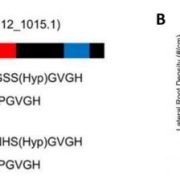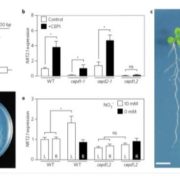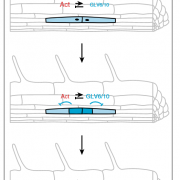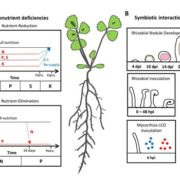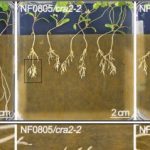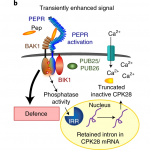Small but powerful: miRNA-derived peptides promote grape adventitious root formation
Magdalena Julkowska, King Abdullah University of Science and Technology
ORCID: 0000-0002-4259-8296
Although plant genomes typically contain hundreds of miRNA encoding genes, we know little about how miRNA expression is regulated (Wang et al., 2019). The expression of Arabidopsis miRNA171, which targets SCARECROW-like transcription factors involved in lateral root formation, was previously described to be controlled by small peptides, derived from small open reading frames (ORFs) on the same primary transcript (pri-miRNA) as miRNA171 itself (Lauressergues et al., 2015) (Fig. 1). This discovery of miRNA-derived peptides (miPEPs) opened the door for new technologies controlling gene expression without the need for genetic modification.
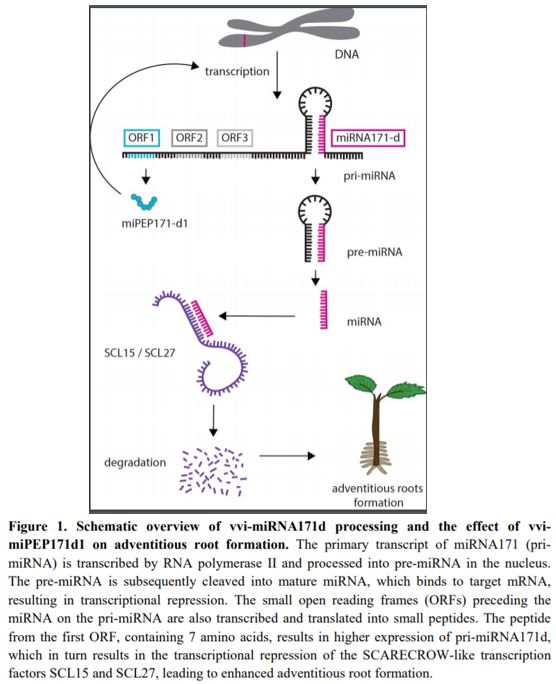 Adventitious root formation is an important agronomic trait in grapevine (Vitis vinifera), as it allows successful propagation by cuttings. In this issue of Plant Physiology, Chen et al. (2020) examined if the adventitious root formation in grapevine could be promoted by targeting specific miRNAs expressed during adventitious root formation. Chen et al., (2020) identified ten grape homologues of miRNA171, and focused on miR171d, the expression of which coincides with the timing of adventitious root formation across multiple grapevine varieties. The team examined a 500-bp sequence upstream of pre-miR171d, and identified three small ORF encoding peptides within this region (Chen et al., 2020). Transient overexpression of individual ORFs indicated that only the first ORF, vvi-miPEP171d1, encoding a peptide of seven amino acids, increased miR171d expression, while application of it reduced expression of the SCARECROW-like transcription factors VvSCL15 and VvSCL27. More importantly, treatment with synthetic vvi-miPEP171d1 increased the number of adventitious roots (Fig. 1; Chen et al., 2020), indicating that the exogenous peptide treatment can be used for grapevine cutting propagation. Intriguingly, while over-expression of grapevine miRNA171d enhanced adventitious root formation in Arabidopsis thaliana, the effect of the small peptide itself was absent, suggesting species-specific conservation of miPEP function.
Adventitious root formation is an important agronomic trait in grapevine (Vitis vinifera), as it allows successful propagation by cuttings. In this issue of Plant Physiology, Chen et al. (2020) examined if the adventitious root formation in grapevine could be promoted by targeting specific miRNAs expressed during adventitious root formation. Chen et al., (2020) identified ten grape homologues of miRNA171, and focused on miR171d, the expression of which coincides with the timing of adventitious root formation across multiple grapevine varieties. The team examined a 500-bp sequence upstream of pre-miR171d, and identified three small ORF encoding peptides within this region (Chen et al., 2020). Transient overexpression of individual ORFs indicated that only the first ORF, vvi-miPEP171d1, encoding a peptide of seven amino acids, increased miR171d expression, while application of it reduced expression of the SCARECROW-like transcription factors VvSCL15 and VvSCL27. More importantly, treatment with synthetic vvi-miPEP171d1 increased the number of adventitious roots (Fig. 1; Chen et al., 2020), indicating that the exogenous peptide treatment can be used for grapevine cutting propagation. Intriguingly, while over-expression of grapevine miRNA171d enhanced adventitious root formation in Arabidopsis thaliana, the effect of the small peptide itself was absent, suggesting species-specific conservation of miPEP function.
The work by Chen et al. (2020) demonstrates that miPEPs can target the desired phenotype with surgical precision. As miPEPs act only in the cells expressing their encoding miRNAs, their application results in a more contextual phenotype (Couzigou et al., 2015), unlike the ectopic overexpression of miRNAs, which impacts multiple agronomically relevant traits (Huang et al., 2017). It is unknown if miPEPs can enhance miRNA expression in the presence of so-called molecular sponges, long non-coding RNAs derived from transposable elements, which reduce miRNA171 in rice (Oryza sativa) during lateral root formation (Cho and Paszkowski, 2017). Although the range of agricultural applications for miPEPs remains to be explored, the results presented by Chen et al. (2020) encourage future efforts to manipulate the regulation of gene expression using miPEPs while circumventing the need for genetic modification.
References:
Chen Q-J, Deng B-H, Gao J, Zhao Z-Y, Chen Z-L, Song S-R, Wang L, Zhao L-P, Xu W-P, Zhang C-X, et al (2020) An miRNA-encoded small peptide, vvi-miPEP171d1, regulates adventitious root formation. Plant Physiol. doi: 10.1104/pp.20.00197 https://doi.org/10.1104/pp.20.00197
Cho J, Paszkowski J (2017) Regulation of rice root development by a retrotransposon acting as a microRNA sponge. Elife. doi: 10.7554/eLife.30038
Couzigou J-M, Lauressergues D, Bécard G, Combier J-P (2015) miRNA-encoded peptides (miPEPs): A new tool to analyze the roles of miRNAs in plant biology. RNA Biol 12: 1178–1180
Huang W, Peng S, Xian Z, Lin D, Hu G, Yang L, Ren M, Li Z (2017) Overexpression of a tomato miR171 target gene SlGRAS24 impacts multiple agronomical traits via regulating gibberellin and auxin homeostasis. Plant Biotechnol J 15: 472–488
Lauressergues D, Couzigou J-M, Clemente HS, Martinez Y, Dunand C, Bécard G, Combier J-P (2015) Primary transcripts of microRNAs encode regulatory peptides. Nature 520: 90–93
Wang J, Mei J, Ren G (2019) Plant microRNAs: Biogenesis, Homeostasis, and Degradation. Front Plant Sci 10: 360




